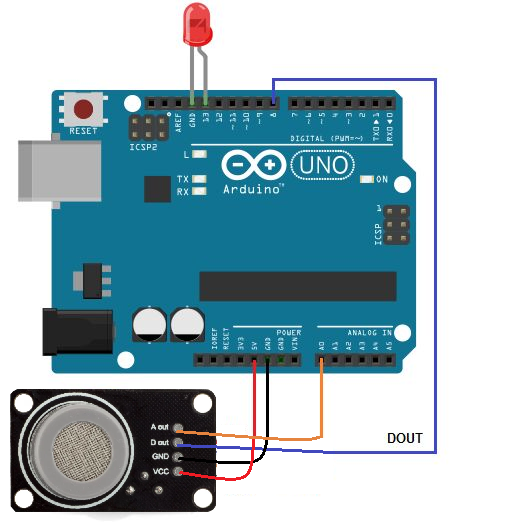AED 25.20
Description
The MQ7 RobotDYN carbon monoxide sensor was created specifically to be sensitive to carbon monoxide (CO) gas that is released by factories, cars, and other sources. The concentration of CO is used to estimate the level of air pollution in a specific area because this gas is thought to be hazardous to people at specific concentrations. the MQ7 RobotDYN carbon monoxide sensor detects 10 to 2000 ppm of CO in the air.
Package Includes:
- 1x MQ7 RobotDYN CO Sensor
Features:
- High sensitivity to CO,iso-butane, and propane
- Good sensitivity to combustible gases in a wide range
- Fast response time
- There are four screw holes for easy positioning.
- Long life Low cost
- Simple drive circuit
- Concentration: 10-10000ppm
- Preheat duration 20 seconds
- Can be used as a Digital or analog sensor
- You can vary the Sensitivity of the Digital pin using the potentiometer
Description:
in the MQ7 RobotDYN gas sensor SnO2, which has a decreased electrical conductivity in clean air, is used as the gas-sensitive material Through high-low temperature cycles, it detects carbon monoxide at low temperature (heated by 1.5V). As the level of carbon monoxide in the air rises, the sensor's electrical conductivity also rises. Using a straightforward circuit, it is possible to translate the change in electrical conductivity into an output signal that corresponds to the gas concentration. The MQ7 RobotDYN gas sensor can be used to detect various gases that contain carbon monoxide because it has a high sensitivity to this gas. It is a cheap sensor appropriate for a number of uses.
Principle of Work:
Gas detection is fairly simple with MQ7 RobotDYN. The analog pin or the digital pin might be used for this. When the module is powered with 5V, the output LED will remain off, leaving the digital output pin at 0V and empty. Before you can use these sensors, they need to be pre-heat for a period of time. If the output LED and digital pin don't go high after you make a gas contact with the sensor, adjust the potentiometer until they do. The digital pin will now go high (5V) if your sensor is exposed to this gas at this specific concentration, else it will stay low (0V). The analog pin can be used to accomplish the same goal as well. Using a microcontroller, read the analog values (0–5V), and this value will be directly proportional to the amount of gas the sensor is detecting. You can play about with these settings to see how the sensor responds to various gas concentrations and adjust your program as necessary.
Pinout of the Sensor:

|
Pin No: |
Pin Name: |
Description: |
|
1 |
Vcc |
This pin powers the module, typically the operating voltage is +5V |
|
2 |
Ground |
Used to connect the module to system ground |
|
3 |
Digital Out |
You can also use this sensor to get digital output from this pin, by setting a threshold value using the potentiometer |
|
4 |
Analog Out |
This pin outputs 0-5V analog voltage based on the intensity of the gas |
Applications:
High CO Gas Concentration Detectors
using a sensor that safeguards the environment is essential. Living rooms with a chimney in it can be equipped with CO gas detectors that use MQ7 RobotDYN sensors.
Air Quality Monitor
By integrating with other IoT systems that can create better ventilation monitoring devices, air monitoring systems that employ MQ7 RobotDYN have a larger potential to improve and recover breathing standards due to their flexibility and low cost.
Circuit:

The Arduino board can be used to connect the MQ7 RobotDYN sensor. the GND pin is linked to the GND pins of the Arduino and the VCC pin is linked to the Arduino board's +5V power source pin, the A out tied to the Arduino board's Analog pin A0. watch the readings on the Serial monitor. use the sensor with CO from a burning piece of paper to check the abrupt changes in readings. As a result, the adjustments are visible on the serial monitor. and if the sensor Value is> 400 the Built-in LED will turn on if the value of the digital out is 1.
Library:
This Module doesn't need any Library to function.
Code:
#define RobotDYNpin 0
float sensorValue; //variable to store sensor value
void setup() {
pinMode(13,1);
Serial.begin(9600); // sets the serial port to 9600
Serial.println(" MQ7 RobotDYN warming up!");
delay(20000); // allow the MQ7 RobotDYN to warm up
}
void loop() {
sensorValue = analogRead( RobotDYNpin); // read analog input pin 0
Serial.print("Sensor Value: ");
Serial.println(sensorValue);
if(sensorValue > 400){
digitalWrite(13,1);
}else{
digitalWrite(13,0);
}
delay(2000); // wait 2s for next reading
}
Technical Details:
- Target Gas: carbon monoxide
- Detectable Concentration: 10-10000ppm CO
- Operating voltage: 5V
- Heating Voltage VH: 5.0V±0.2V ACorDC(hight); 1.5V±0.1V ACorDC(low)
- Load Resistance RL: Adjustable
- Heating Resistance RH: 31Ω±3Ω(Room temperature)
- Heating Power PH: ≤350mW
- Surface Resistance of Sensitive Material R: 2KΩ-20KΩ(in100ppmCO)
- Sensitivity S: Rs(in air)/Rs(100ppmCO)≥5
- Concentration Slope: α ≤0.6(R300ppm/R100ppm CO)
- Temperature, Humidity: 20℃±2℃; 65%±5%RH
- Standard Test Circuit: Vc:5.0V±0.1V; VH(high): 5.0V±0.1V; VH(low): 1.5V±0.1V
Resources:
- Information about MQ gas sensor series
- Introduction to Gas Sensors: Construction Types and Working
- Tutorial with code : Arduino CO Monitor Using MQ7 RobotDYN Sensor – Instructables
- Tutorial with code : Arduino lesson ? MQ7 RobotDYN Gas Sensor – Osoyoo
- Datasheet – MQ7 RobotDYN
Comparisons:
When it comes to measuring or detecting a particular Gas, the MQ series Gas sensors are the most commonly employed. If you want to track a gas' ppm levels, it is advisable to only buy the sensor not the module. Due to the MQ7 RobotDYN's high sensitivity for CO and sensing range of 10–10,000 PPM, we advise utilizing it in houses alongside co-detection systems rather than the MQ-2, which monitors gas concentration from 100–10,000 PPM.